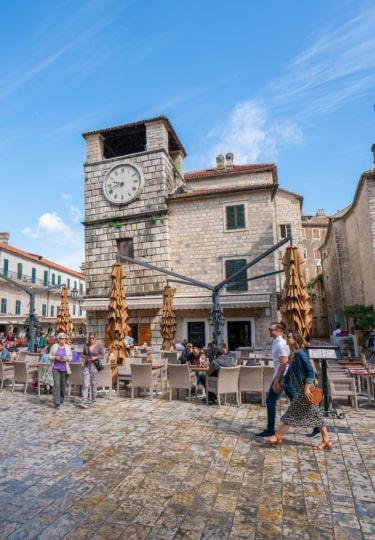Tucked into the innermost tip of the Bay of Kotor, the town of Kotor is every bit as dazzling as Montenegro’s undulating Adriatic coastline.
There are plenty of things to do in Kotor for culture lovers, with travelers barely able to turn a corner without bumping into another ancient church or historic landmark. Kotor also offers plenty to do for more active visitors, including hiking in national parks and kayaking and swimming in the beautiful bay.
From exploring wineries to relaxing on glorious beaches, and hiking up Lovćen Mountain, discover the best things to do in Kotor on vacation.
Wander Kotor Old Town
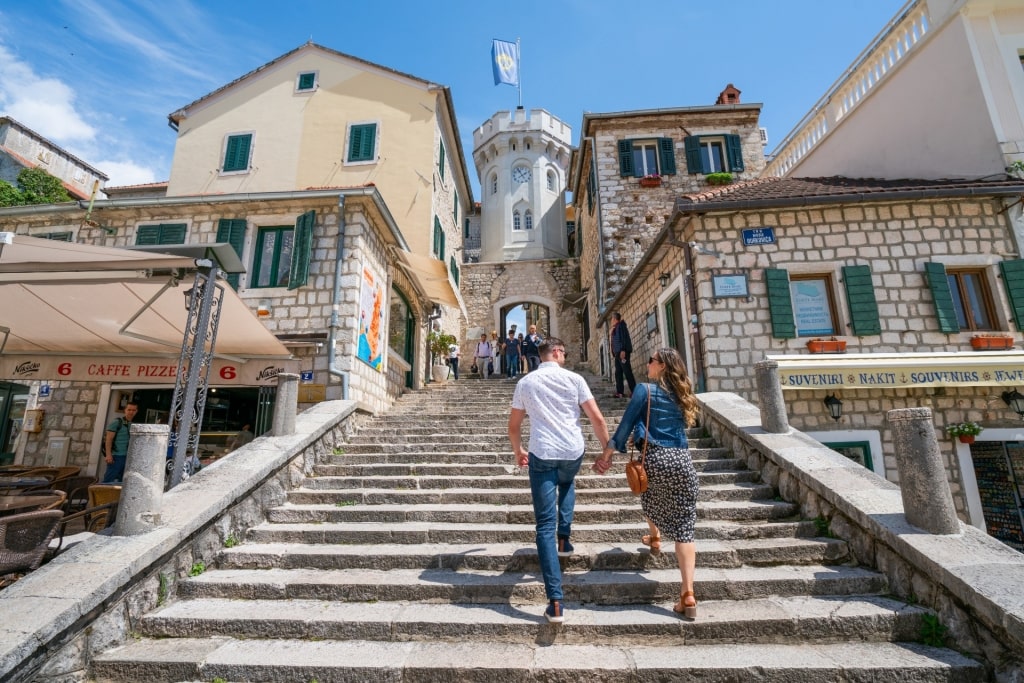
Old Town
One of the most satisfying things to do in Kotor, especially for first-time visitors, is to explore the enchanting Old Town, defined by apricot-hued rooftops, Romanesque churches, and pretty squares.
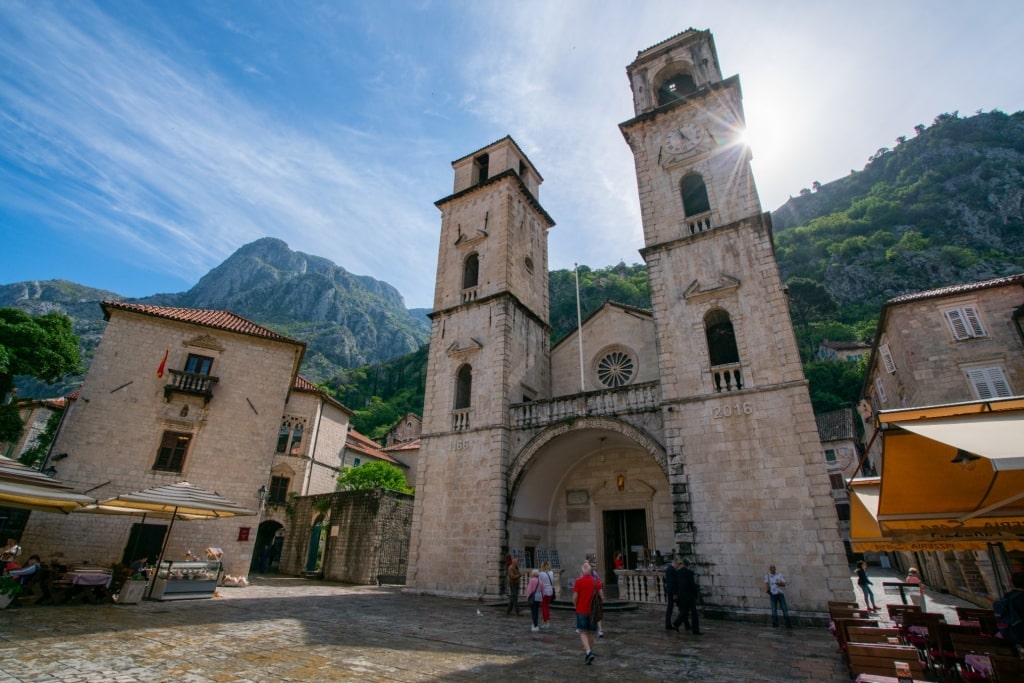
Cathedral of St. Tryphon
Start by visiting the Cathedral of St. Tryphon, which towers above the higgledy-piggledy Old Town. Built in the 12th century on the site of an earlier church, the cathedral has been rebuilt over time due to damage caused by earthquakes. St. Tryphon’s twin bell towers were added in the 17th century following a fire that devastated the front of the building.
Admire the cathedral’s treasured gilded altar, baroque frescoes, vaulted ceilings, and slender columns. Wander upstairs to the Sacral Art Museum to view paintings and artifacts, including a wooden crucifix from the 12th century.
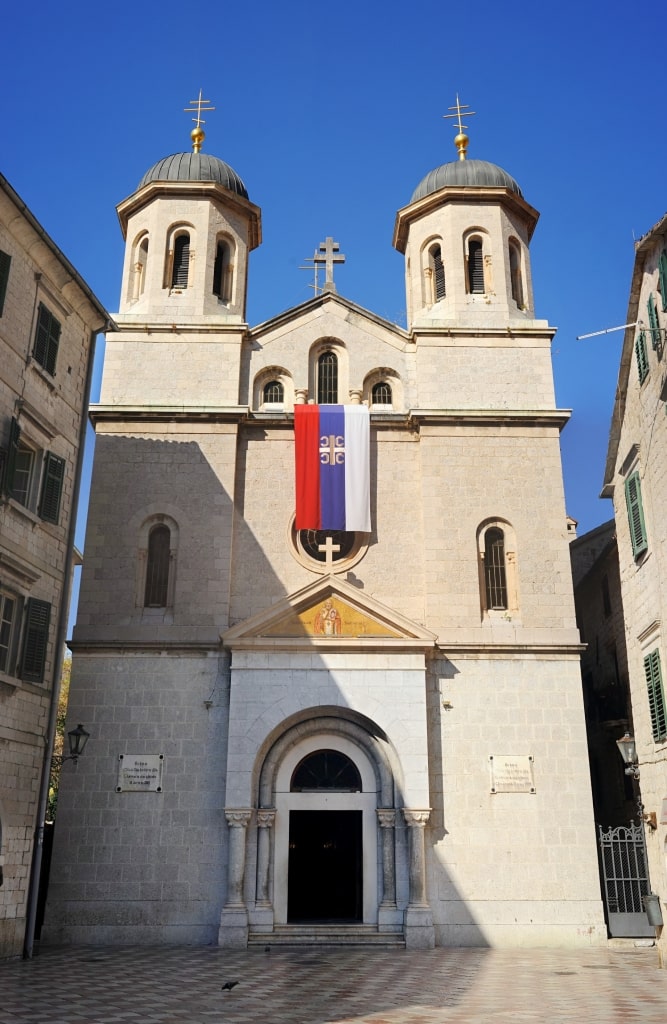
St. Nicholas Church
Visit one of the newer buildings in the Old Town, the dashing St. Nicholas Church, an Orthodox church built at the start of the 20th century.
You could also stop by the Maritime Museum to explore the country’s seafaring history. Antique maps, models of old galleys and sailboats, and navigational instruments are on exhibit.
Save time for shopping, too. Kotor Old Town’s maze of narrow streets are lined with ceramic, jewelry, and antique stores. Afterward, take a seat at a pavement café to savor dishes of stuffed squid, grilled octopus, and freshly made flatbreads soaked in olive oil.
Bask on Zanjice Beach
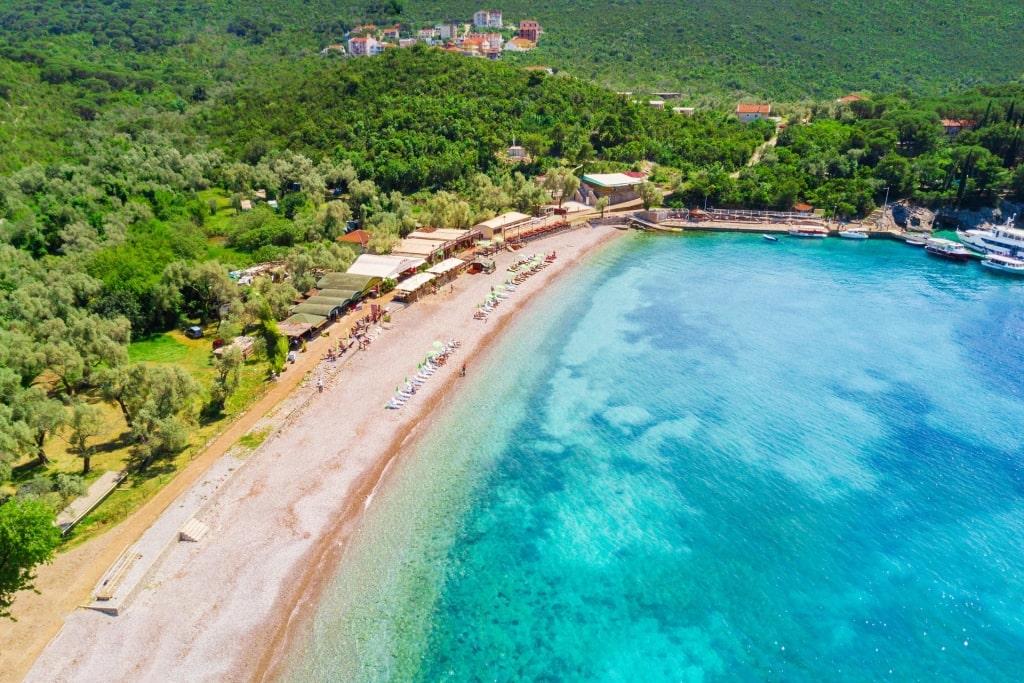
Zanjice Beach
The early 19th-century British poet Lord Byron once wrote: “The most beautiful merging of land and sea occurred at the Montenegrin seaside.” He was on the mark; spending time at the Montenegrin seaside is one of the best things to do in Kotor.
Head to Zanjice Beach, one of the best beaches in Montegro, on the Lustica Peninsula. Creamy-colored pebbles fill this crescent-shaped patch, just a 40-minute drive west of Kotor.
Wear aqua shoes and enjoy a refreshing dip in the clear, aquamarine water. Relax on a sun lounger and take shade under a parasol. If you’re feeling more active, hire a jet ski or enjoy a walk around the green headland.
You’ll find a couple of casual restaurants right on the beach serving salads, seafood, and pizzas.
Sail to Our Lady of the Rocks
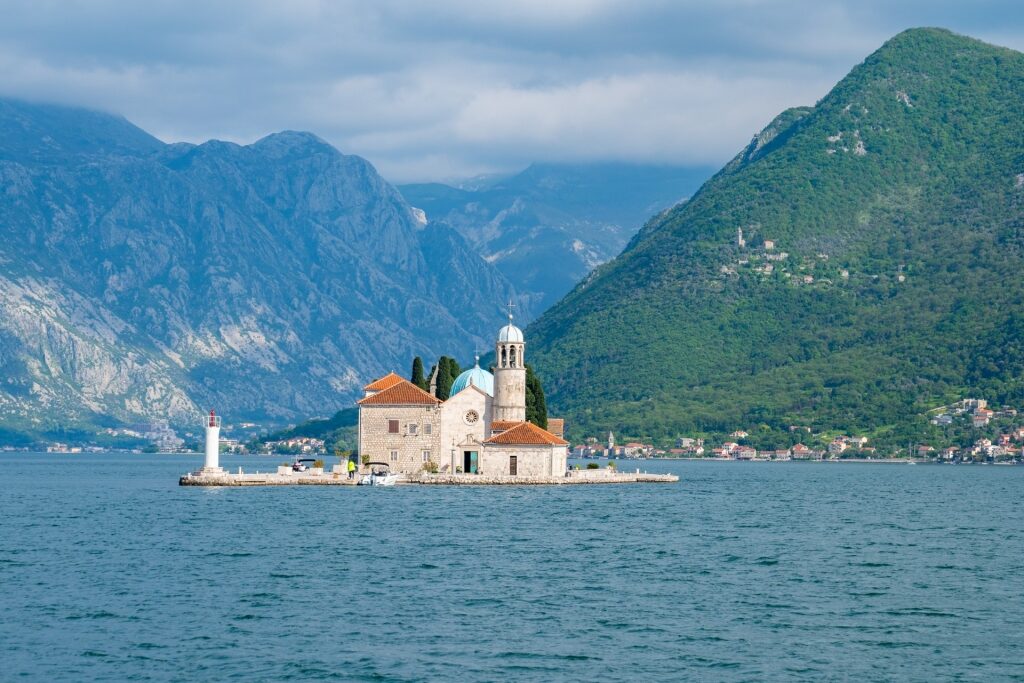
Our Lady of the Rocks
One of the best places to visit in Montenegro is the tiny island of Our Lady of the Rocks, near the town of Perast.
To reach the island, travelers can either take a private taxi boat from Kotor or the local ferry service from the island’s nearest town, Perast.
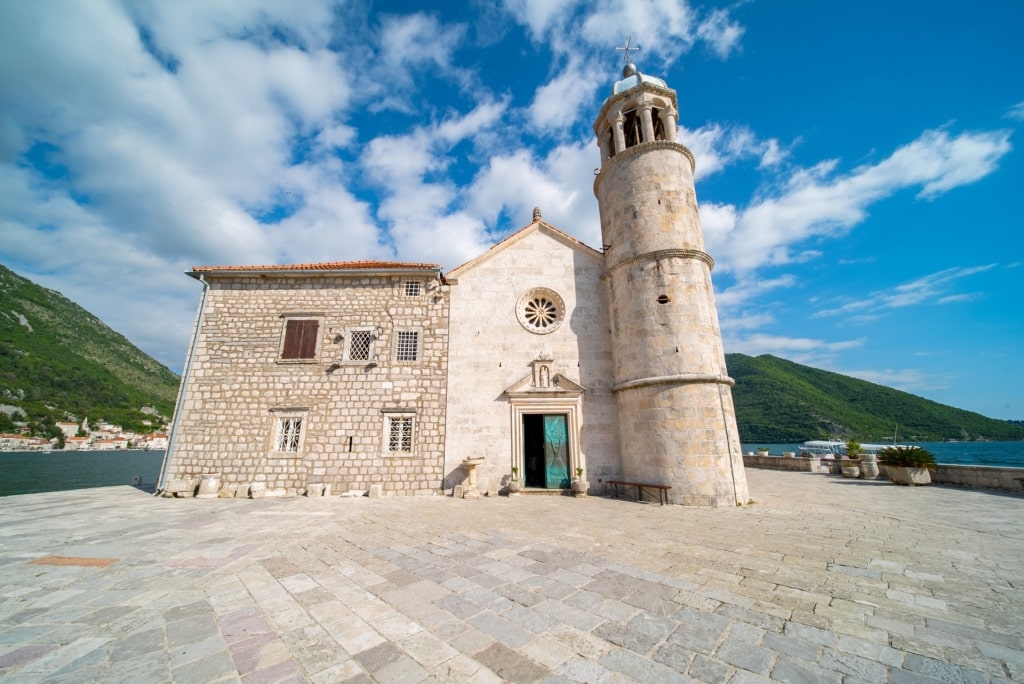
Our Lady of the Rocks
The island’s church, featuring a circular tower and domed roof, shimmers on the emerald-green water. According to legend, the island was little more than a pile of rocks when two local fishermen discovered an image of the Virgin Mary here in 1452. This led to a small Orthodox chapel being built, later replaced by a Catholic church built by the Venetians in the 17th century.
The showpieces of the church include a 15th-century icon of Virgin Mary by Lovro Dobričević and a Carrara-marble altar by Genovese sculptor Antonio Capelano. Once you’ve explored the church, stop by the small museum on the island to learn about the history of Perast.
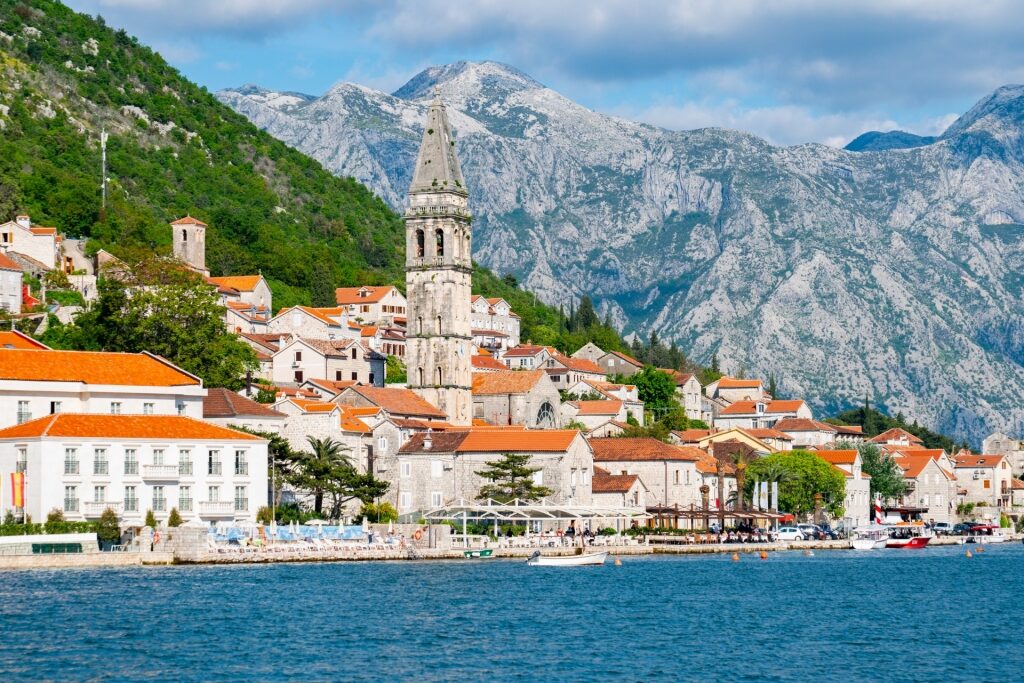
Perast
One of the best things to do in Kotor is to relax in Perast. Do this at a waterfront restaurant after your trip to Our Lady of the Rocks.
Enjoy a Scenic Drive to Lovćen Mountain

Lovćen Mountain
Located within Lovćen National Park, this dramatic mountain offers spectacular views of Montenegro’s craggy landscape from its 5,738-foot perch.
Lovćen’s terrain is covered in dense green beech, oak, and linden forests, home to around 2,000 plant species.
Deer, wolves, bears, and wild boars, plus around 200 bird species, and 11 reptile species are also found in this wild corner of Europe.

Petar II Petrović-Njegoš mausoleum
Among the action-packed activities on offer are hiking, quad biking, zip-lining, and rock climbing. For a more serene path to the peak, drive to the mausoleum of former Montenegrin ruler and poet Petar II Petrović-Njegoš.
At 5,446 feet high, it’s the highest mausoleum in the world. Drive to the mausoleum’s parking lot and from there walk to the tomb. Be warned, though, there are 461 steps to climb.
Explore Skadar Lake National Park
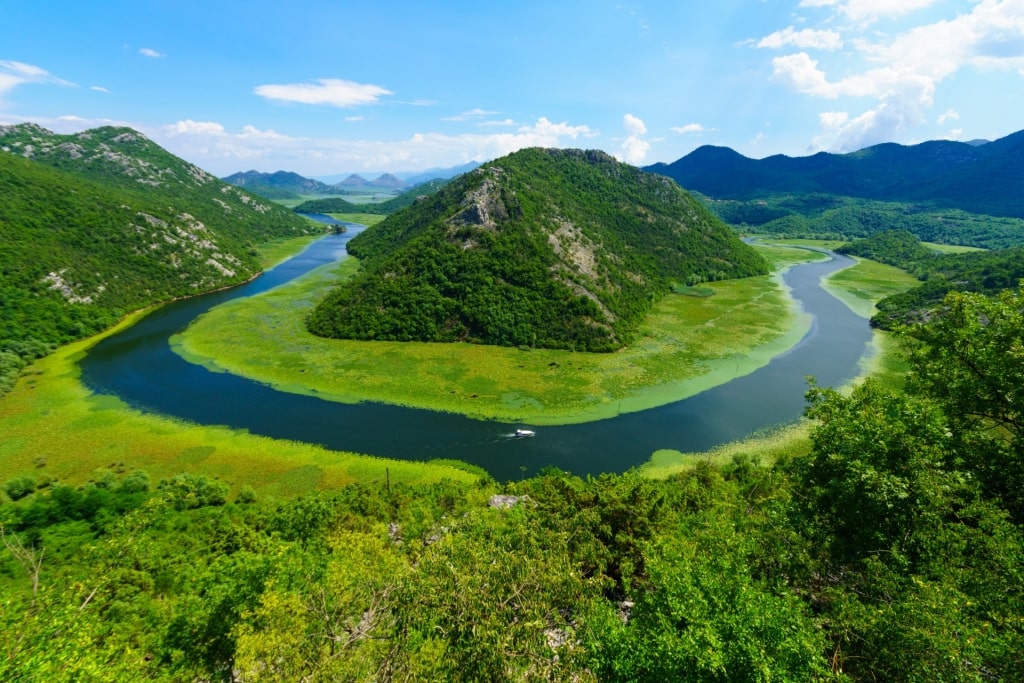
Skadar Lake National Park
Straddling Montenegro and Albania, Skadar is home to mountains, monasteries, wineries, and on the lake, thousands of green water lilies.
Make the one-hour journey from Kotor to Skadar Lake National Park, stopping at Pavlova Strana Viewpoint on the northwest tip of the lake. Here you’ll witness magnificent postcard views of the Rijeka Crnojevića river and the coast of Skadar Lake.
Bird watching is popular in Skadar Lake, with five ornithological stations in locations including Grmožur and Pančevo Oko.
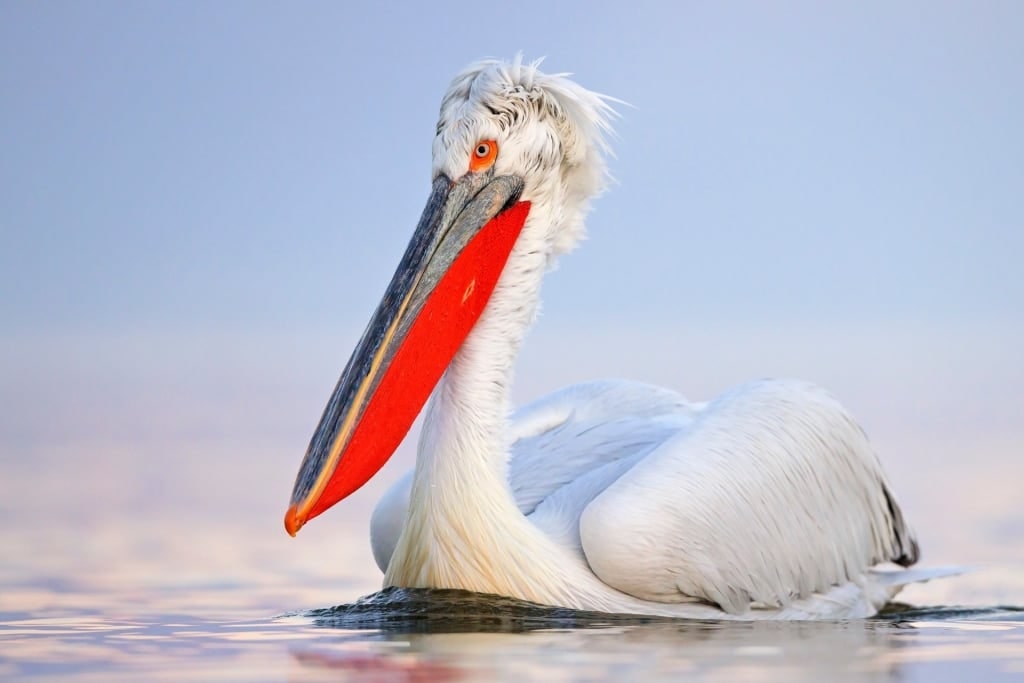
Dalmatian pelican
Skadar National Park attracts hundreds of species, including little egret, white spoonbill, cormorant, and the world’s largest freshwater bird, the rare and endangered Dalmatian pelican.
There are also 50 species of fish and three types of snakes that reside in Skadar Lake. To take in the lake’s wildlife, you could join a tranquil boat tour. Standup paddle boarding, biking, and hiking are also popular activities.
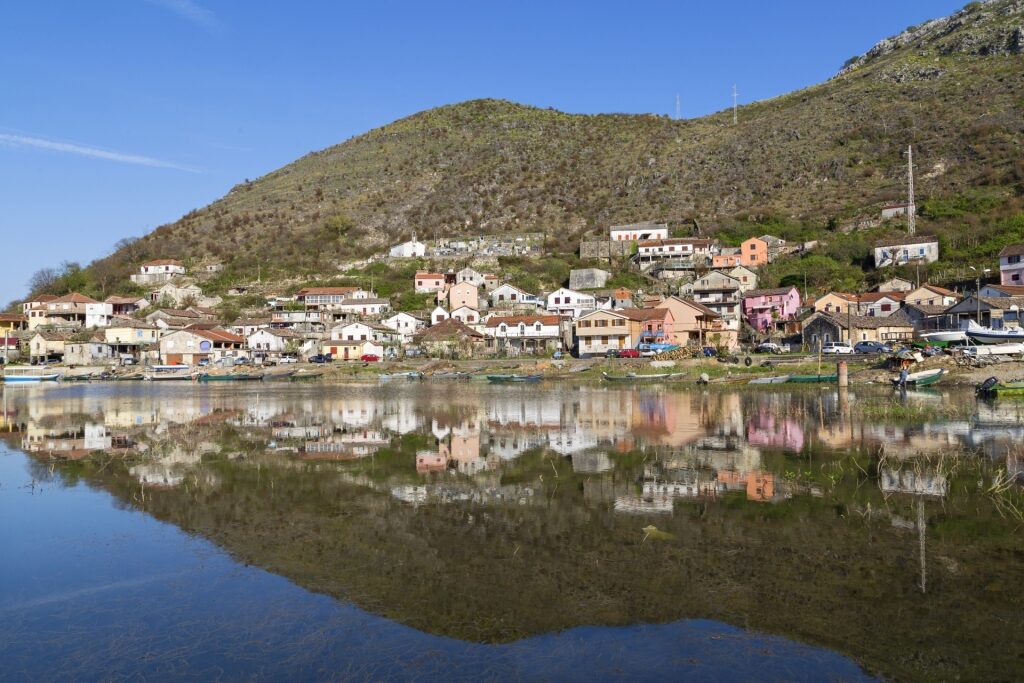
Vranjina
Stop in the village of Vranjina where you could rent a boat, tour Vranjina Monastery, and learn more about the lake and its ecosystem at the visitor center.
Try the local specialty, smoked, fried or broiled carp, one of the lake’s most common fishes.
Restaurant Silistria in the attractive village Virpazar is a top-rated spot.
Kayak in Kotor Bay

Kayaking in Kotor Bay
Take in the breathtaking scenery of the fjord-like Kotor Bay, known locally as “Boka”, on a kayaking trip.
Hemmed in by steep cliffs, Boka’s shoreline is illuminated by a string of villages and towns, including Kotor, Risan, Tivat, Perast, Prčanj, and Herceg Novi. You’re technically on the Adriatic Sea here—but as the bay extends 17 miles in from the coast, there’s actually a sense of being on a dramatic fjord.
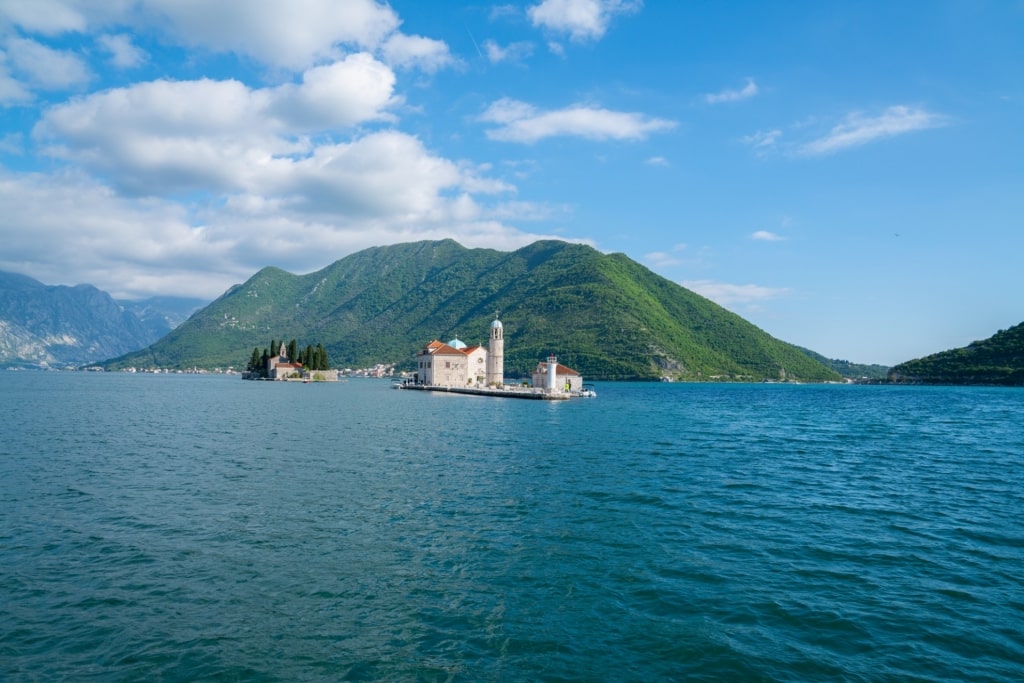
Our Lady of the Rocks
Join a guided session from Kotor Beach and you could paddle for miles in the bay’s inky waters. Head for the two tiny islands, Our Lady of the Rocks and St. George, and enjoy a break at one of the bay’s beaches, Verige or Morinjska plaža.
Remember to wear swimwear so you can cool off with a dip in the sun-dappled water.
Go Wine Tasting
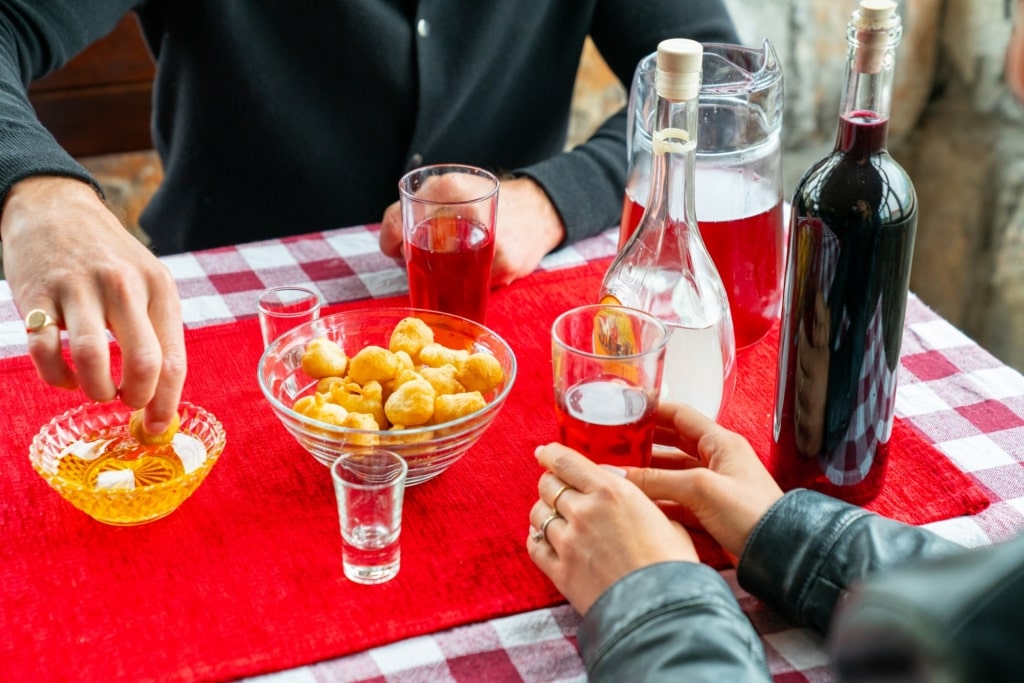
Wine
Thanks to its warm Mediterranean climate, Montenegro’s rugged landscape is crisscrossed with verdant vineyards producing delicious wines.
Skirt the Bay of Kotor and travel into the countryside to Winery Dabovic. Have your camera ready to capture the far-reaching mountain views as you head north.
Winery Dabovic is an organic family-owned vineyard in the village of Nudo. The winery was previously named Imperial Vineyards, noted for supplying wines to the royal court in Vienna during the period of the Austro-Hungarian Empire.
Saunter among the rows of leafy vines and enjoy a food and wine pairing at the winery’s restaurant. In addition to wines, the organic farm produces vegetables, honey, and dairy products.
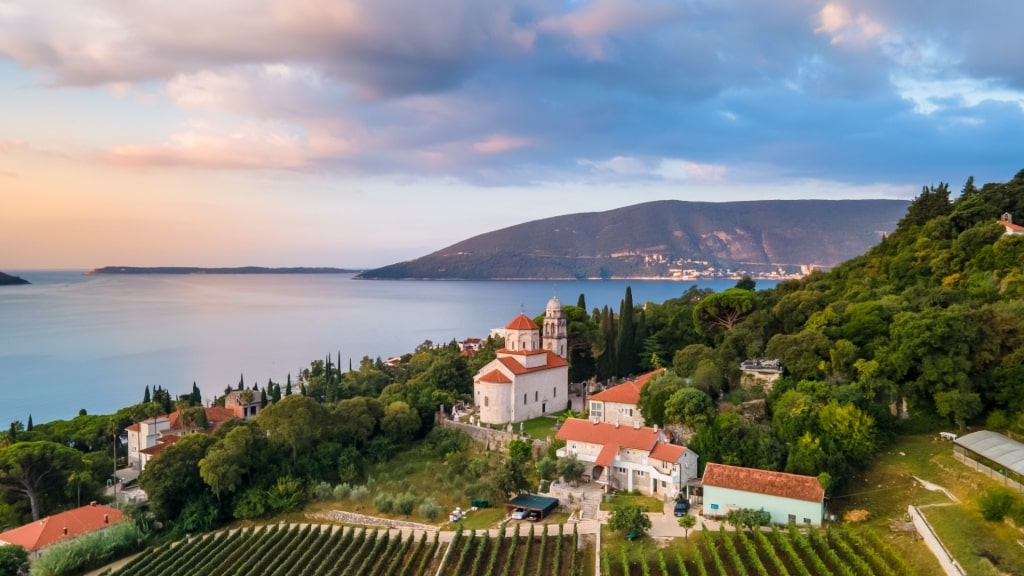
Savina Winery
You could also visit Savina Winery, next to Savina Monastery, on a hillside in the Bay of Kotor’s north shore. Here, wines are aged in French oak barrels in the estate’s cellar, with merlot, cabernet sauvignon, chardonnay, and a rosé grenache produced.
While Savina Winery is a far more recent setup than Winery Dabovic, this idyllic south-facing spot has been covered in vineyards for centuries. Wine lovers can visit the winery by reservation for a private vineyard and winery tour, wine tasting and food pairing.
Read: Best Places to Visit in the Mediterranean
Discover Glamorous Budva
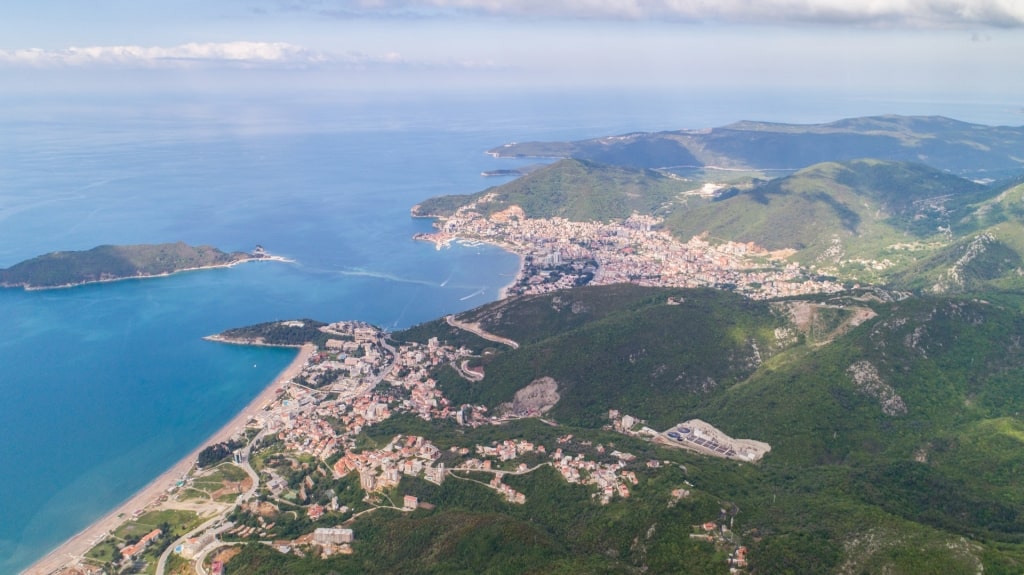
Budva
Glitzy Budva is a starry standout of Montenegro’s yacht-filled riviera. A necklace of beautiful beaches with gin-clear water line Budva’s stretch of coastline, while the marina is bursting with shiny boats.
If you’re in the mood to spend the day at the beach, Slovenska Plaza and Bečići are the largest and most central shores. Lively Jaz Beach is made up of two coves separated by towering cliffs. They all offer sunbeds, parasols, bars, and restaurants.
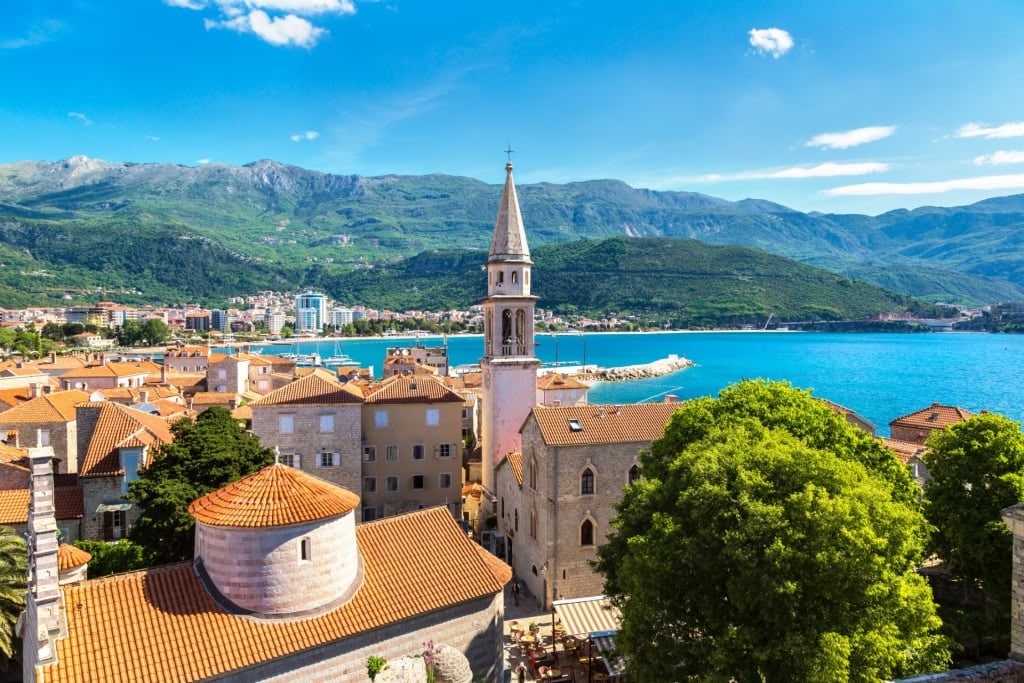
Old Town Budva
You should also spend time strolling around Budva’s Old Town. At 2,500 years old, it’s one of the oldest settlements in the Balkans.
Explore the cluster of terracotta-topped stone buildings and twisting cobbled streets that are encased within the Budva’s ancient city walls. Top-drawer cafés, restaurants, and boutiques lie side-by-side with historic churches and museums.
Climb to San Giovanni Fortress

San Giovanni Fortress
The ruined San Giovanni Fortress looms almost 1,000 feet above Kotor Old Town. San Giovanni is part of Kotor’s defensive labyrinth of fortresses, ramparts, walls, and towers, which together have earned UNESCO-listed status.
San Giovanni Fortress is cleverly positioned to offer sublime views of the Old Town and Kotor Bay. To get there, follow the steep, zigzagging route, which coils up the hillside.
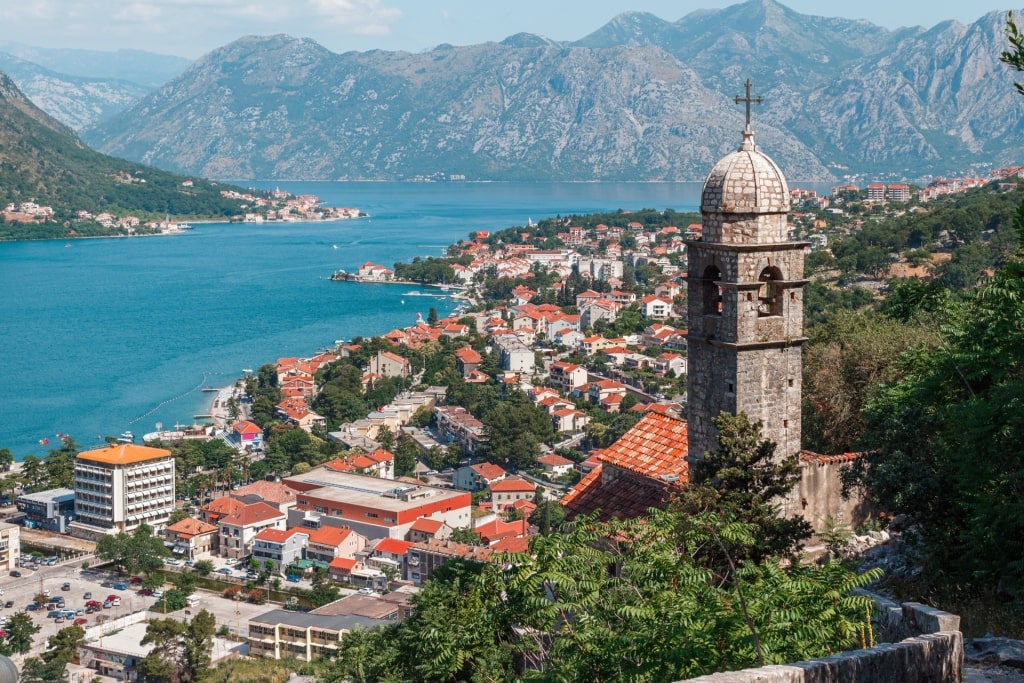
Church of Our Lady of Remedy
Stop at another Kotor landmark, the early 16th-century Church of Our Lady of Remedy, to break the journey.
With over 1,300 steps to climb, you should take the walk at a leisurely pace and carry plenty of water. Wear a sun hat, especially in the peak of summer (July and August) when Kotor can feel extremely hot.
Journey to the Blue Cave
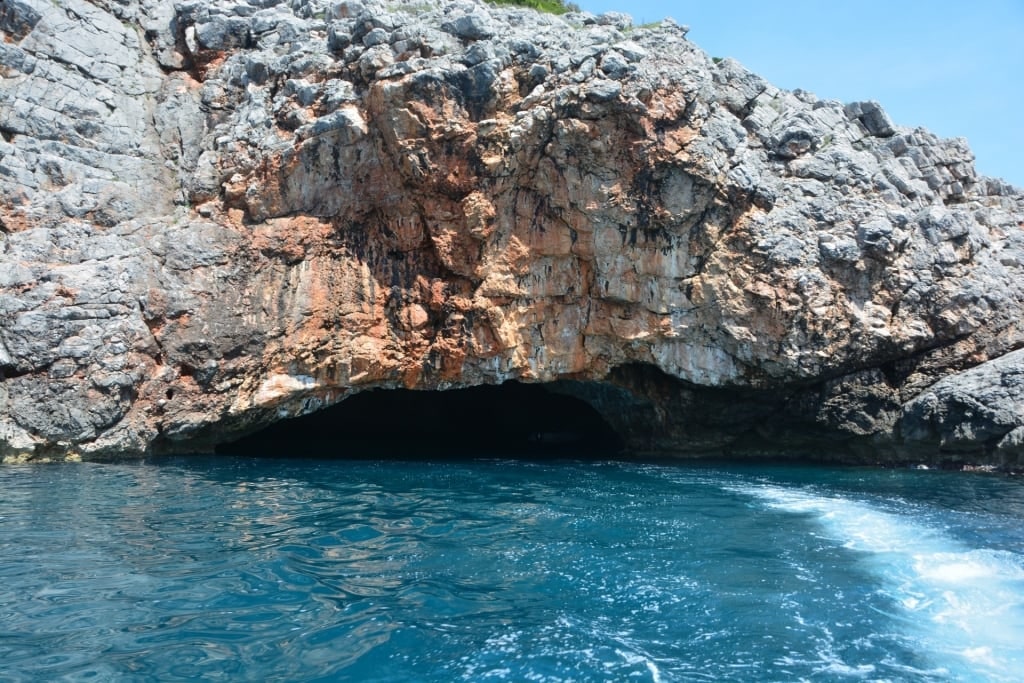
Blue Cave
The Blue Cave is carved into Montenegro’s gorgeous Lustica Peninsula, a stretch of coastline that’s dotted with natural grottoes. The Blue Cave reaches 30 feet high and is believed to be the largest of the peninsula’s caves.
The best way to reach the Blue Cave is via a leisurely sojourn from Kotor, which will take you through the Bay of Kotor and out into the Adriatic Sea.
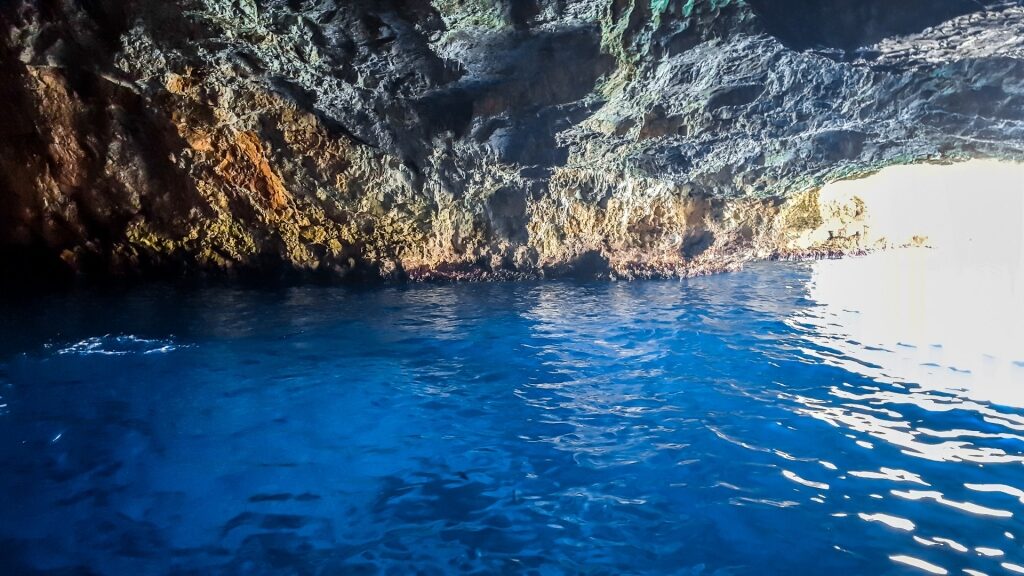
Blue Cave
Small vessels, canoes, and kayaks can sail directly into the twinkling cave. The water’s inviting sapphire hue is likely to tempt you in to swim and snorkel.
Drive to the Village of Njeguši

Njeguši
The pastoral village of Njeguši lies on the slopes of Mount Lovćen, a 45-minute drive east of Kotor.
The twisting drive to Njeguši passes through Kotor Serpentine, a stretch of road featuring several back-to-back elbow-shaped bends. Find a safe observation spot to pull over and gaze at the sweeping views that stretch over the Bay of Kotor.
Njeguši is best known as the birthplace of Petar II Petrović-Njegoš, Montenegro’s influential leader, or prince-bishop, and a poet whose lofty mausoleum lies atop Mount Lovćen.
You could explore the two-story house where Njegoš was born, now a museum. The museum displays ethnographic artifacts and small pieces of crafted weapons.

Njeguši
A wander through the mountain village will reveal several restaurants serving the town’s indulgent delicacies; cheese, honey, and Pršut, a dry-cured ham similar to Italy’s prosciutto.
Make a lunch reservation at Nevjesta Jadrana, sitting at an altitude of 3,116 feet on the town’s main road. Sample the Njeguški pršut, Njeguški sir (cheese), and honey or cheese fritters with a carafe of ruby-red Vranac, the region’s rich and fruity red wine.
Trace Kotor’s Old Town Walls
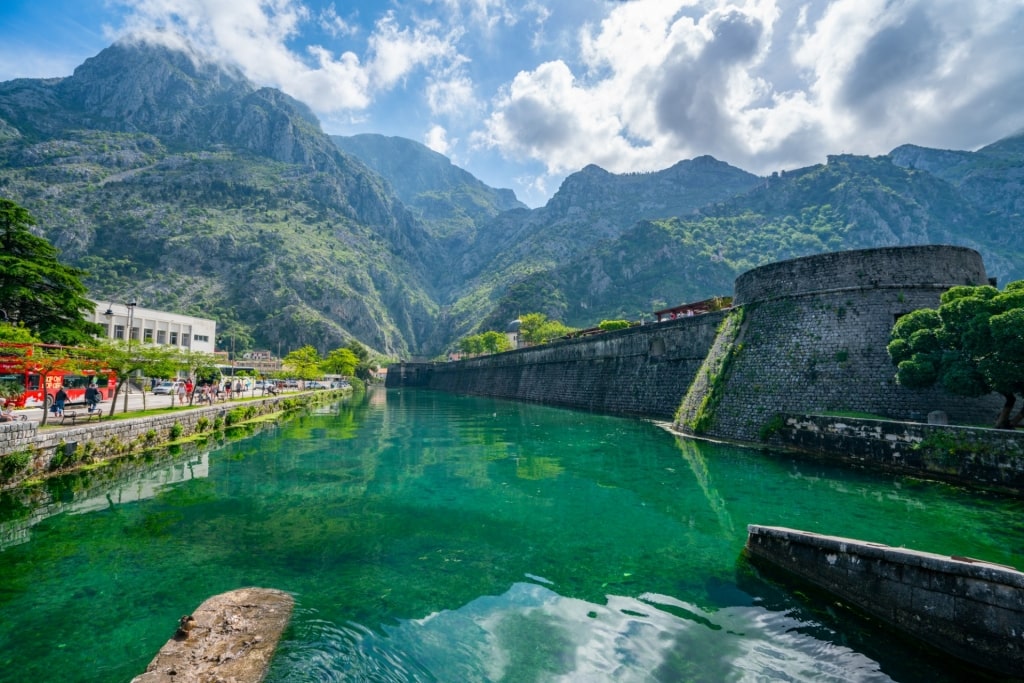
Old Town
Kotor’s triangle-shaped Old Town is guarded by a series of forts, gates, and walls. Tracing sections of the walls is one of the best things to do in Kotor to really appreciate the breadth of this medieval fortification.
Follow the palm tree-lined city walls south from the circular Kampana Tower. Located at the northwest tip of the triangle, this imposing bastion rises from the green-blue lagoon.
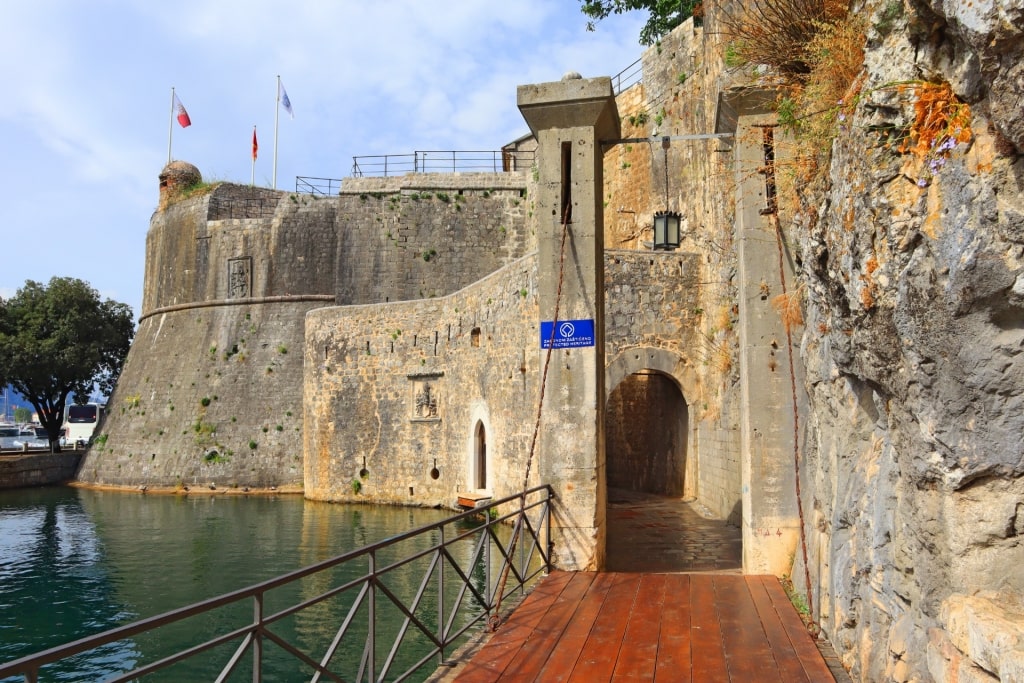
Gurdic Gate
From the Sea Gate—the Old Town’s main gate, facing the water—continue to the southern tip of the “triangle”. Marvel at the Gurdic Gate, also called the South Gate, and the viridescent Gurdić Spring.
Gaze up towards San Giovanni Fortress and you’ll see the remains of more walls and bastions, snaking up the green hillside.
Explore the Maritime Museum of Montenegro
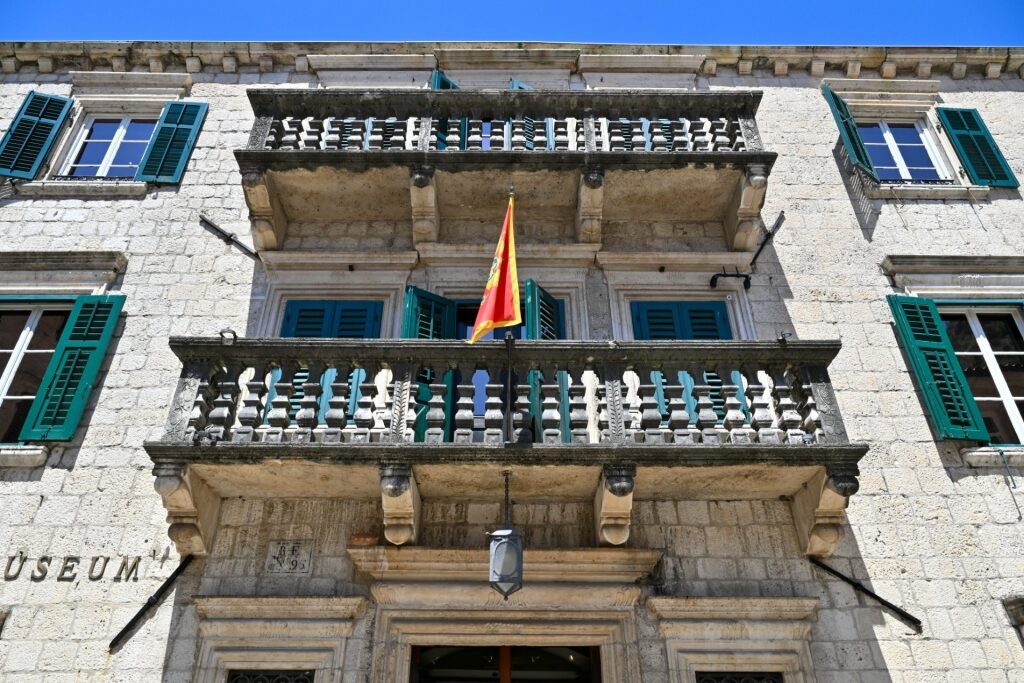
Maritime Museum of Montenegro
Kotor’s shipping and its seafarers played a significant role in the history of the Adriatic. That’s highlighted in the Maritime Museum, housed in the ornate Grgurina Palace, a former private home built in the Venetian style.
The museum’s collections span several centuries with ship models, navigational instruments, paintings, and historical maps among its exhibits. You’ll also find weapons, flags, and naval uniforms to bring to life some of the historical conflicts that have affected Montenegro.
Ships’ logs and artifacts from local sailors and captains add a more personal touch to the collection. The Maritime School, founded in 1849 but with a history dating to the 14th century, is also remembered with certificates and many other mementos.
Look Out From Kampana Tower
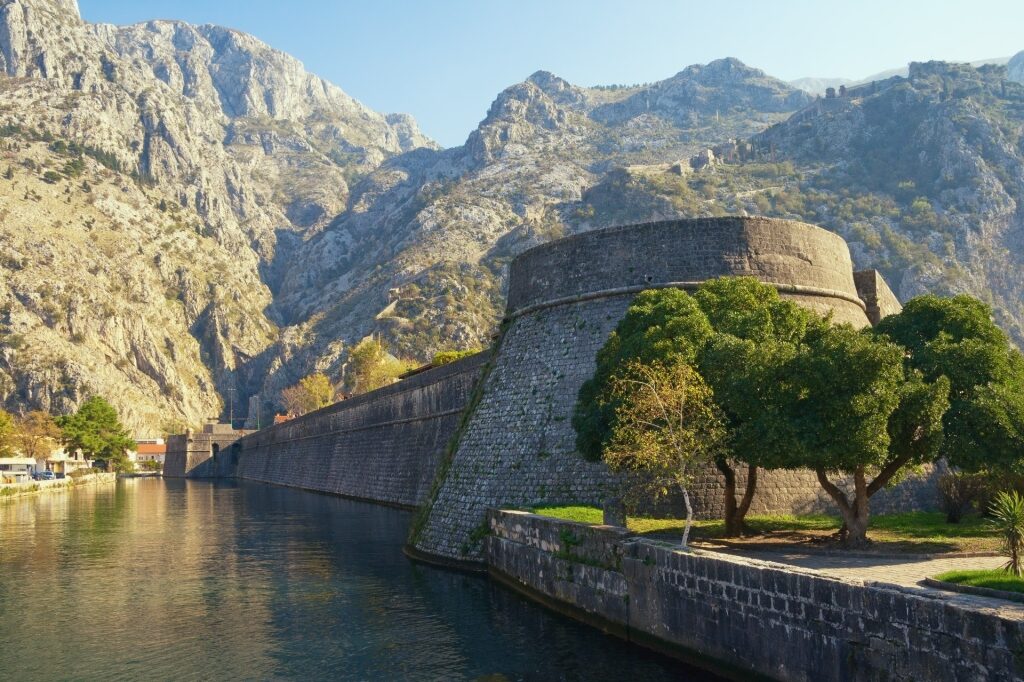
Kampana Tower
The Kampana Tower is the most prominent of the Kotor’s many towers and bastions. It guards the entrance to the Skurda River at a corner where the river-facing north wall and west wall meet.
Its name comes from a bell that once tolled out to warn citizens of any danger. The tower, already several centuries old then, was completely rebuilt by the Venetians in the mid-16th century.
The conical shape, designed to withstand cannon fire, is a marked contrast to the angular style of the surviving earlier towers. From the 66-foot-high battlements, you can appreciate the Kampana Tower’s strategic position while enjoying a panoramic view.
Shop in Kotor Bazaar
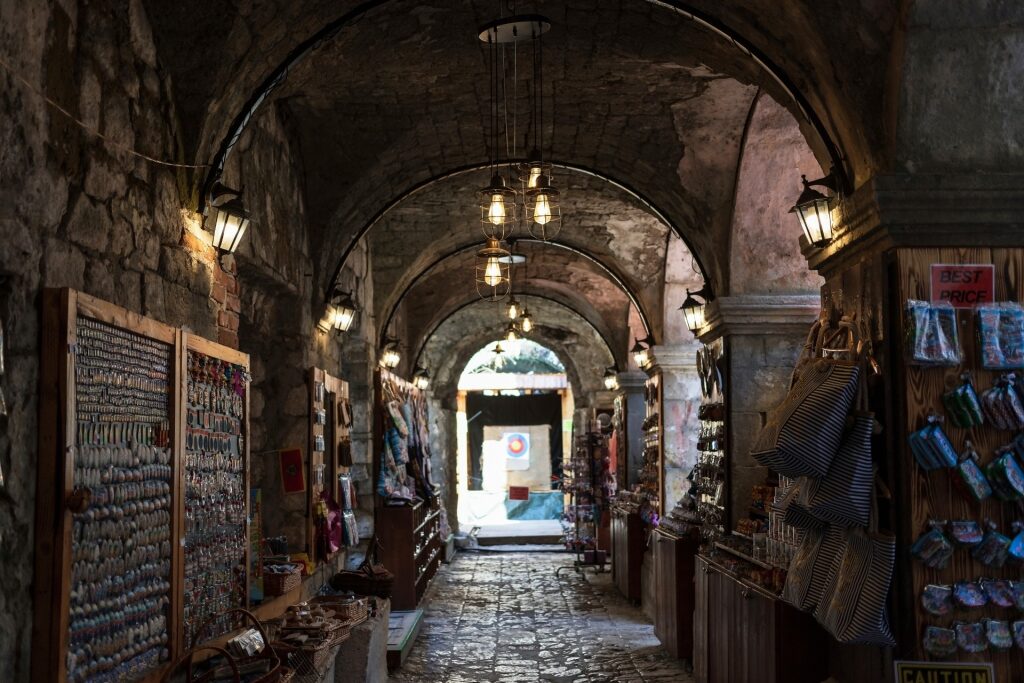
Kotor Bazaar
Galerija Tician, better known as Kotor Bazaar, is a former 15th-century Dominican monastery. Destroyed in the 1667 earthquake, it was restored as a military barracks before opening as a shopping gallery in 2018.
The high, arched galleries make for a cool space on hot days and a dry one on wet days. One of the best things to do in Kotor is to browse the stalls here for unusual souvenirs and personalized gifts.
A number of local painters have stands in the bazaar, as do many other craft makers. The ancient setting, colorful people, and variety of goods on sale also make for good photographs.
Relax With Kotor’s Cats
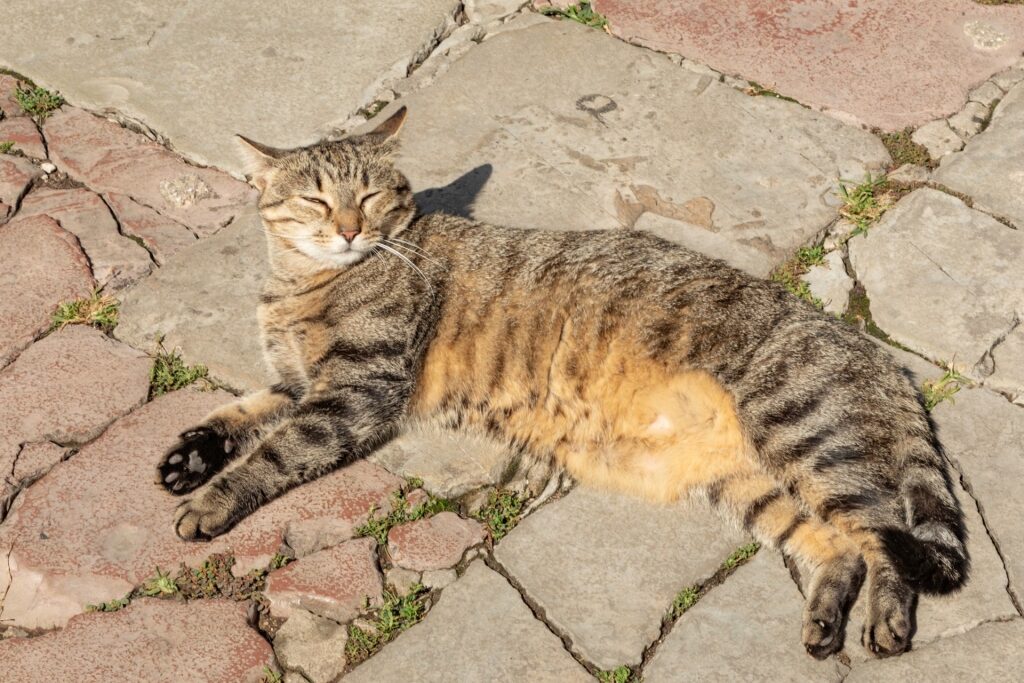
Cat
Cats have a long history in this Eastern European city, which is linked to its seafaring history. Welcomed aboard ships to keep rats under control, cats have lived around the port since at least the 14th century.
You’ll find colonies in places such as Pima Palace, St. Luke’s Square, and Wood Square—better known as Cat Plaza. Some cats are so fixed in place that locals will use them as landmarks when giving directions.
While it’s tempting to feed them, that’s best left to those who look after them year-round. You can buy a cat calendar sold in shops for a charity working to keep the population healthy.
Kotor also has a Cat Museum, stuffed full of feline-themed postcards, gifts, and other quirky souvenirs. Again, a share of the proceeds from here goes to help care for the town’s cats.
Look Into St. Nicholas Church
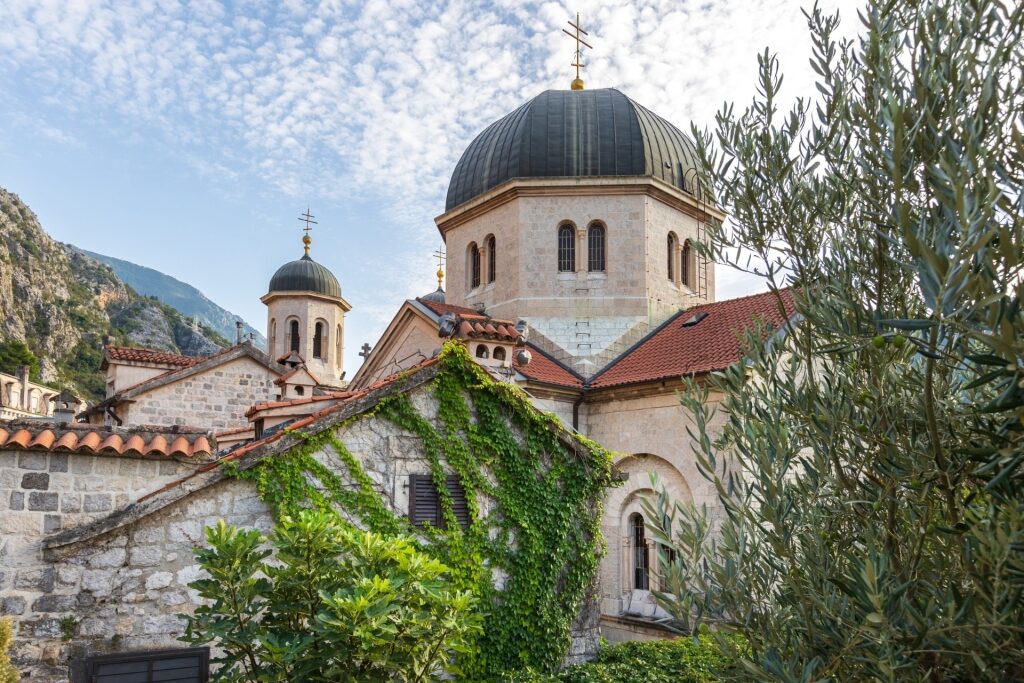
St. Nicholas Church
Although built in 1902, the Byzantine style of St. Nicholas makes it appear much older. The simple facade of this Serbian Orthodox Church hides a richly decorated interior.
Icons decorated in gold and silver form a massive screen, or iconostasis. Local artists and silversmiths provided most of its detailing, including chandeliers and candelabra.
St. Nicholas is the patron saint of sailors, so local seafarers have a close connection to him. A treasury nearby holds many precious objects, including vestments donated to the church.
Admire Pima Palace
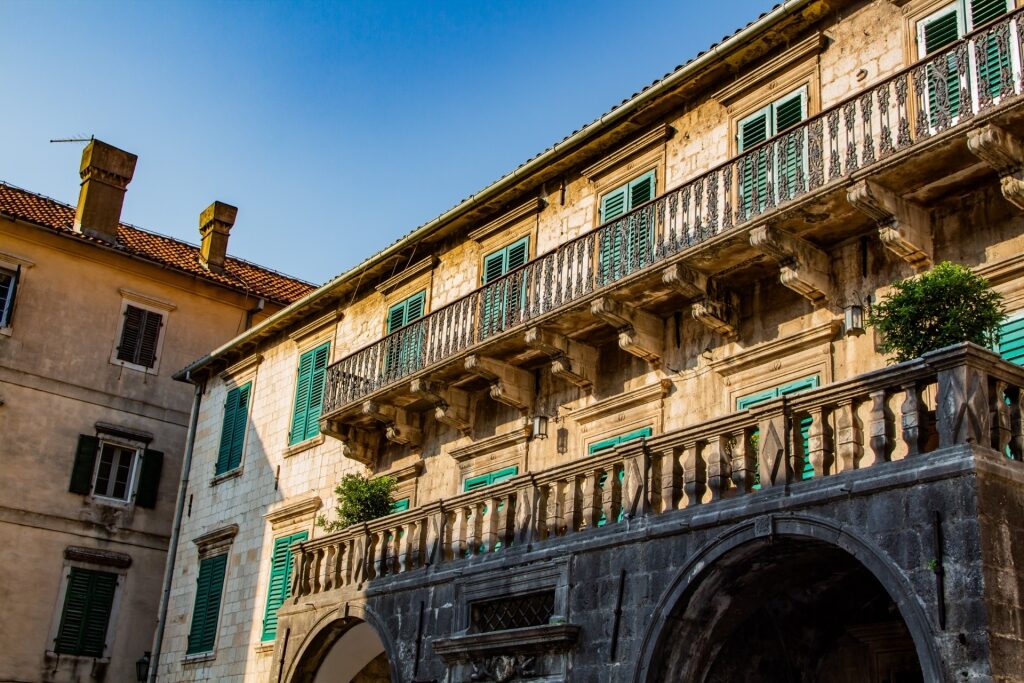
Pima Palace
The wonderful 17th-century Pima Palace blends Baroque and Renaissance styles into an ornate whole. It was first built after a major 1667 earthquake and restored after the most recent in 1979.
The noble Pima family included Jeronim Pima, the first poet to write in the local language rather than Italian. Their coat of arms, featuring two angels, can be seen above the door.
A prominent feature of the palace is the wrought ironwork on its front balcony. Inside, an art gallery features 400 works by artists from the former Yugoslavia, most from the 1970s.
Check the Time at the Clock Tower
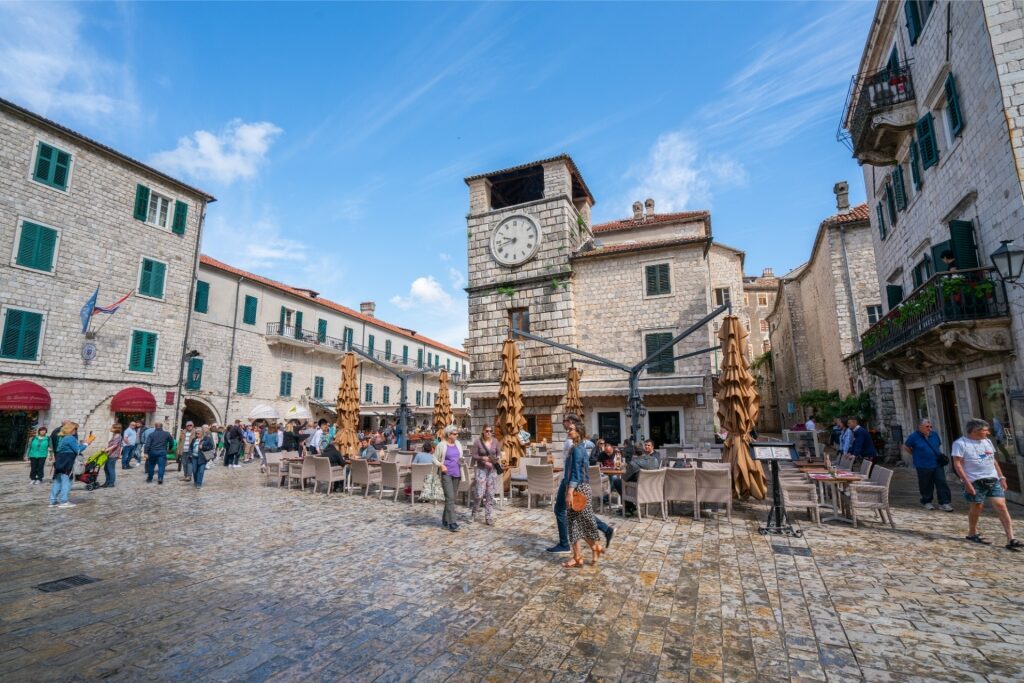
Clock Tower
The three-story Clock Tower dates to 1602 and survived the earthquake of 1667. Damaged during the 1979 earthquake, it has been carefully restored since.
You may notice that the two clock faces each have the Roman numeral IV rendered as IIII. This is a tradition with many older clocks, perhaps because it gives a more symmetrical look.
In front of the tower is a thin, pyramid-shaped obelisk, known as the “Pillar of Shame”. This is where petty criminals were once bound to face abuse from townsfolk.
Have a Strudel in Square of the Arms

Cherry strudel
The Clock Tower looks over Trg od Oružja, The Square of Arms, the main plaza of Kotor. Also the town’s largest square, it’s named for a Venetian arsenal that once stood here.
Around the square are many historic buildings in varying architectural styles. These tell the story of Kotor’s past, from Venetian rule through Napoleon-era French rule to the Austro-Hungarian era.
The square is where most visitors enter the Old Town via the imposing Sea Gate. A good introduction to local cuisine is to eat a traditional cherry strudel in one of the square’s many cafés.
Taste Local Produce at the Farmers’ Market
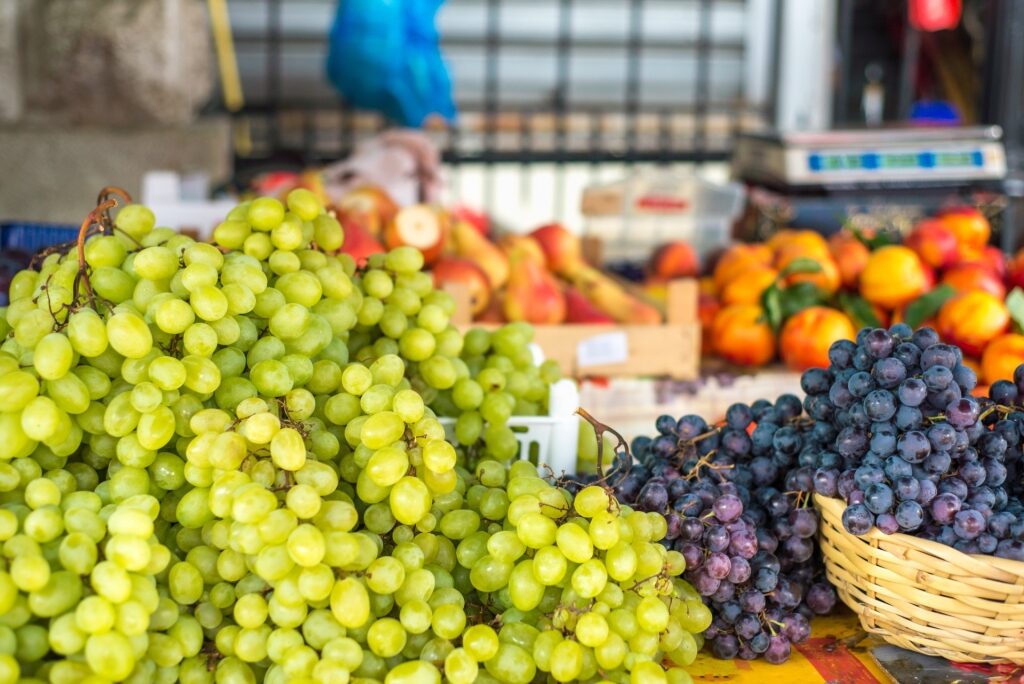
Kotor Farmers’ Market
Just outside the Sea Gate on the harbor front is a morning farmers’ market, open until 2 pm. It’s small but lively, and a wonderful place to taste and smell local produce.
You’ll find everything from wild blackberries and basil cheese to pine honey and sun-dried mountain figs. Some of the other produce, such as sausage or cheese, is vacuum wrapped, for ease of packing.
You’ll need some cash in smaller bills to make the most of the shopping experience. Apart from shopping, it’s the kind of colorful setting beloved by photographers.
Sail in the Kotor Semi Sub
Anyone with children or grandchildren will find that sailing on the Semi Sub is one of the best things to do in Kotor. It can’t promise Caribbean coral reefs and tropical fish, but it’s a unique way to learn more about the Adriatic.
The bright red boat is a semi-submersible, with clear windows in a viewing deck underwater. You can see the many species of fish that swim around in what is often called “Europe’s southernmost fjord”.
In fact, Kotor Bay is a ria, an ancient river bed drowned by rising seas. Finding out facts such as this about the bay, its aquatic life, and maritime history will be the real highlights of your voyage onboard.
Visit St. Luke’s Church
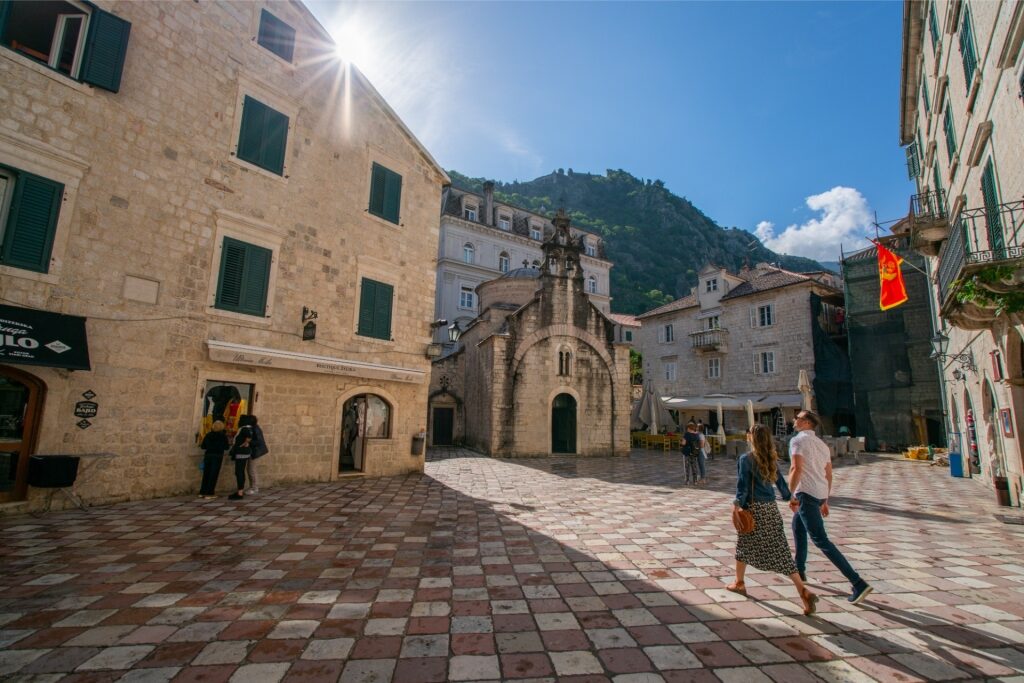
St. Luke’s Church
Crkva Svetog Luke—St. Luke’s Church—is one of Kotor’s most unusual religious buildings. It dates to 1195 and its architecture reflects the transition from Romanesque to Gothic during that era.
You’ll need a good guide or guidebook to pick out the Byzantine and Romanesque features that make the church so interesting. It’s among the few medieval churches in the region to have survived unscathed not only earthquakes but also war.
Formerly a Catholic church, St. Luke’s was given over to Orthodox worship in the mid-17th century. It has two altars and several other features that reflect this shared usage.
Hear About the Legends of Karampana Fountain
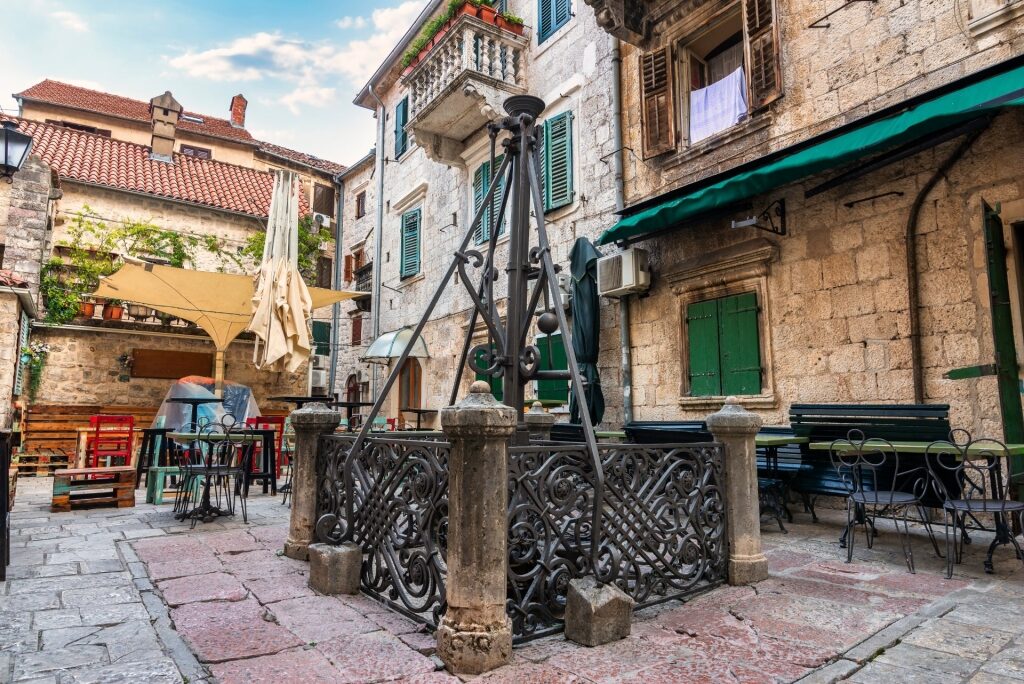
Karampana Fountain
This fountain in Trg od Brasna—Square of Flour—was Kodor’s first public water fountain. Its intricate ironwork and well-worn stonework attest to its long history.
Built in the 17th century, Karampana Fountain was the place to hear news and match-make, as well as draw water. Those traditions are no doubt still carried on in the many busy cafés and bars nearby.
Also reflecting its long history, there are several local legends connected to the fountain. A good guide is essential to hear some of the best.
Sample Some Local Food
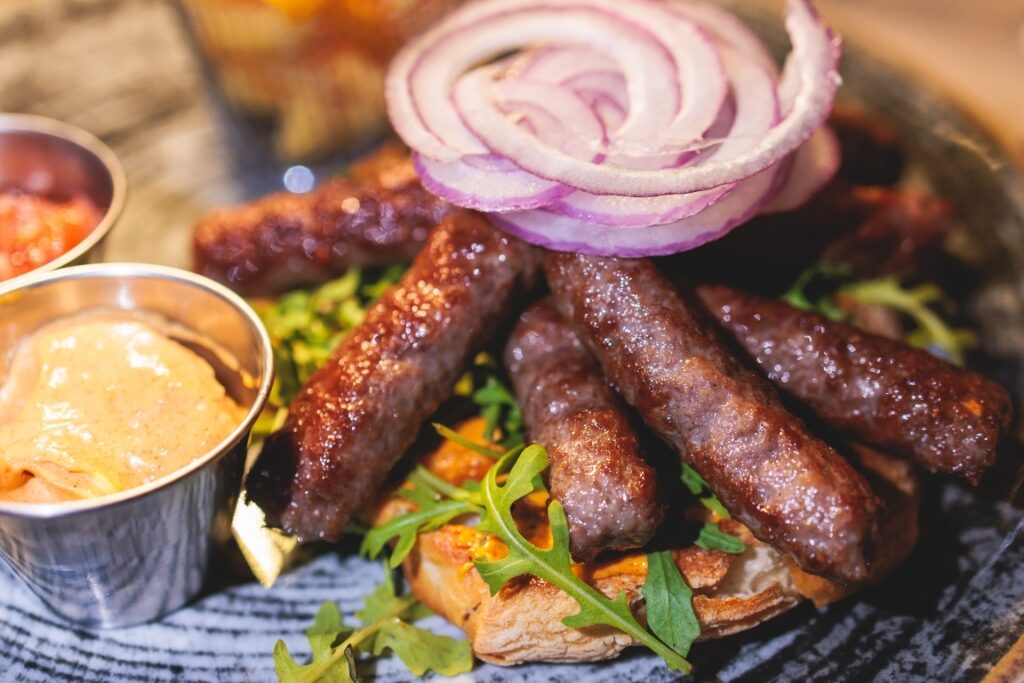
Cevapi
Kotor’s local foods include such dishes as smoked meat with cabbage, or slow-cooked beef in wine sauce. Street food might be cevapi—small, grilled sausage in pita bread—or burek—phyllo pastries filled with meat, cheese, or spinach.
You can sample these and more in local cafés, restaurants, or in local homes. A number of host families also offer the opportunity for visitors to join them in a meal and even learn how to cook it.
Going further afield, a few families in the mountains near Kotor also host lunch or dinner guests. Using fresh ingredients from their own gardens or smokehouses, their meals highlight the best in home cooking.
Read: European Food Guide
Ride Kotor Cable Car
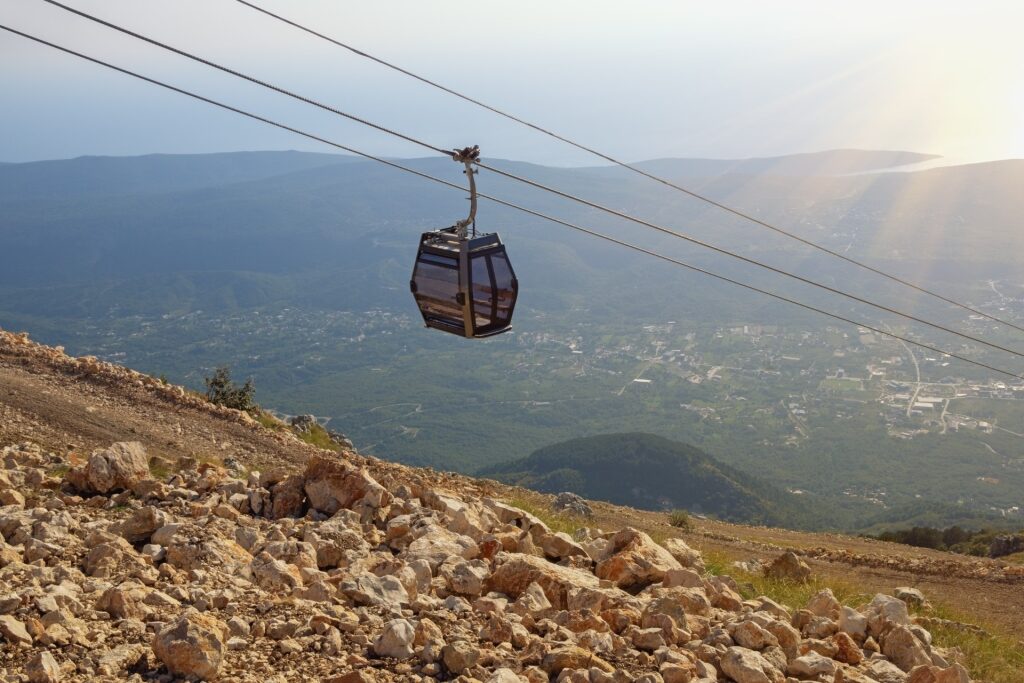
Kotor Cable Car
The modern Kotor Cable Car—opened only in 2023—will whisk you up on a 12-minute ride to the top of Kuk Hill. From here, you have great views of the surrounding mountains and the Bay of Kotor.
You can take in that view on high from the 1350 Bar, Restaurant Forza Kuk, or while walking around. You can also rent a bike or take a hike to explore Lovćen National Park.
You could walk back down via the Ladder Of Kotor—much easier than the reverse route. However, returning by the cable car gives you a second chance to admire the amazing scenery.
Enjoy the Alpine Coaster
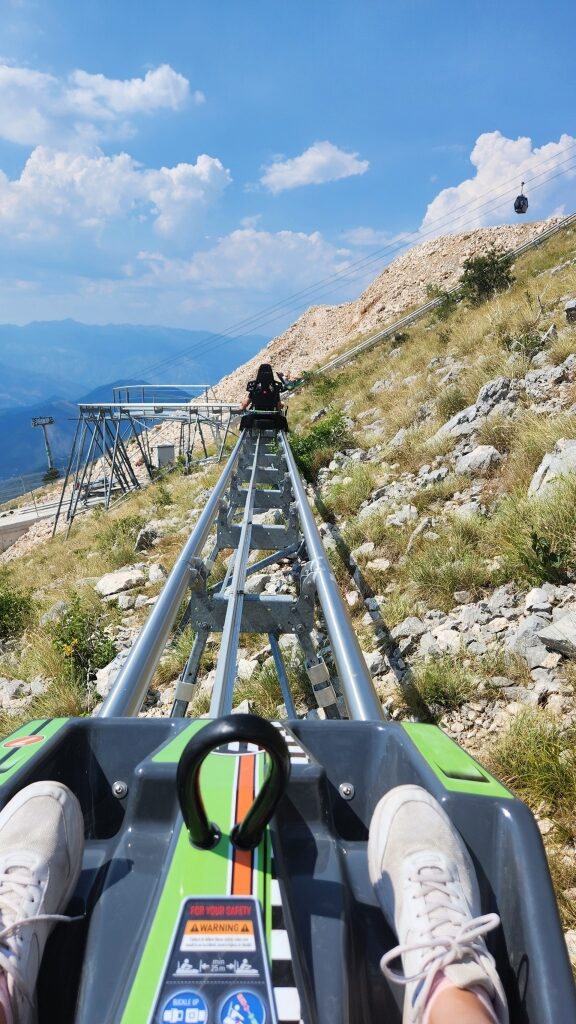
Alpine Coaster
A “coaster”, not a roller coaster, the Alpine Coaster is a relatively serene experience near the upper Kuk Station for Kotor Cable Car. You ride individual sleds down metal rails in a beautiful natural setting.
The coaster takes you on a gentle curving route across the hillside, passing through stands of trees. A brake lets you adjust your speed—which tops out at 25 mph anyway—to whatever you are comfortable with.
There are wonderful views over the mountains and Kotor Bay. Lovćen Mountain can be cloudier or mistier than the town below, so do check the weather on the day.
Climb the Ladder of Kotor
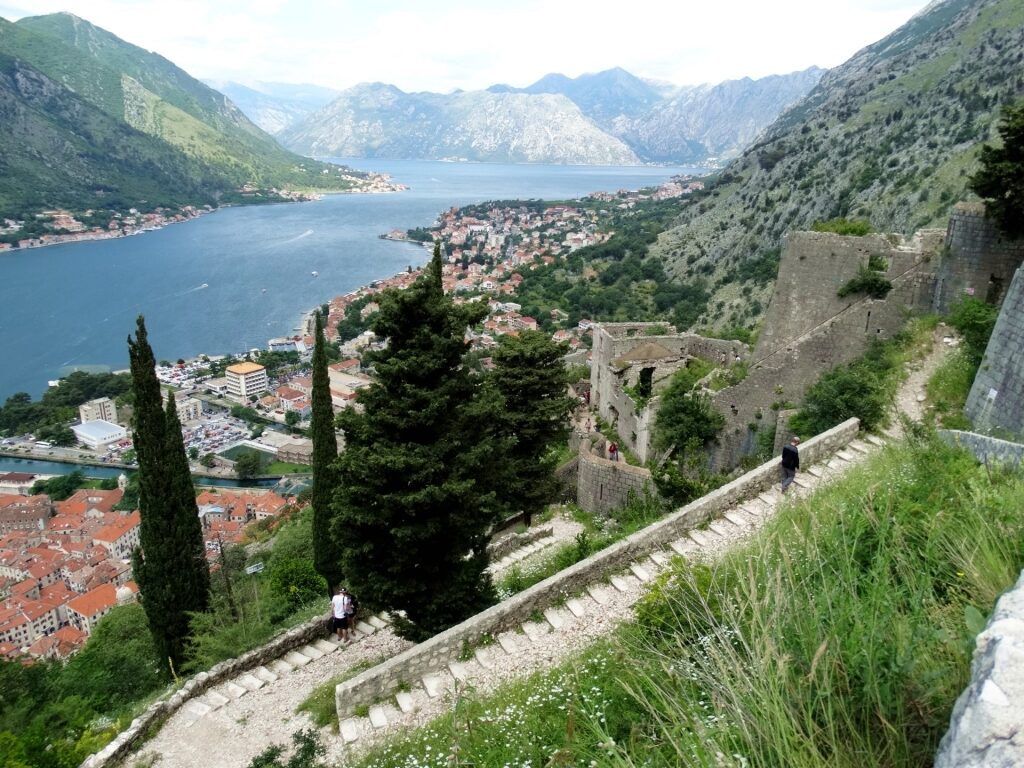
Ladder of Kotor
The switchback trail up the mountains behind Kotor, past San Giovanni Fortress, leads to Krstac Pass. The amazing views from the top take in Kotor Bay, the Old Town, and the Adriatic.
The trail was built during Austrian rule as a military road to Montenegro’s royal capital, Cetinje. With some 70 switchback bends, it was also used by farmers taking produce to the market in Kotor.
A good destination is Restaurant Nevjesta Jadrana, an eight-mile round trip, which is very hard work on a hot day. However, the well-marked trail quickly gains altitude, so you will have a rewarding view after even a short hike.
Hike to Fort Vrmac

Fort Vrmac
Another popular hike is to Fort Vrmac, overlooking the west side of Kotor Bay. A five-mile return walk runs from the Old Town to this picturesque fortification.
Dating to 1897, Fort Vrmac was built by the Austro-Hungarian Empire. Heavily damaged during World War I, it was later restored and remains one of the best-preserved examples of its type in the region.
You can explore the fort, whose impressive walls are still fighting a battle against nature. However, standing at 2,575 feet, the views from the top alone are worth the hike.
Stroll Kotor Promenade
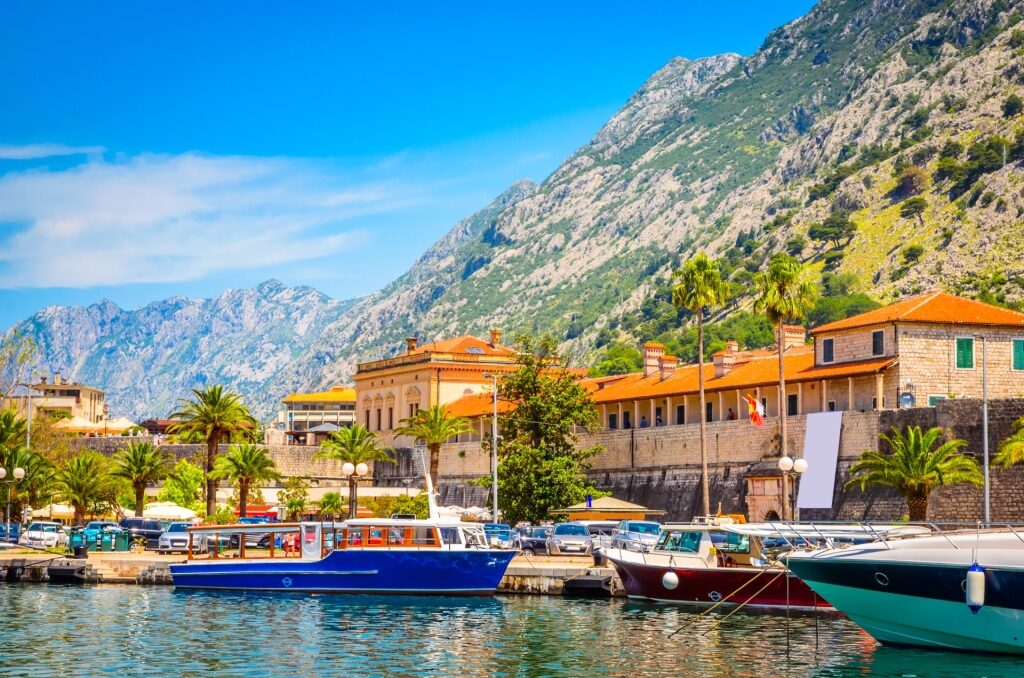
Kotor Promenade
In contrast to the mountain hikes around Kotor, there’s an easier walk along its seaside promenade. With historic buildings on one side and the Bay of Kotor on the other, it’s very scenic in its own way.
The promenade is usually busy and is lined with cafes, so it’s a great people-watching experience as well. Admire the city walls, take in the architecture, and photograph the bobbing boats.
The well-paved walk will take you to Dobrota in about 20 minutes. Here the small but fascinating Aquarium Boka—the local name for the Bay of Kotor—showcases species from the Adriatic.
Eat & Catch Fish
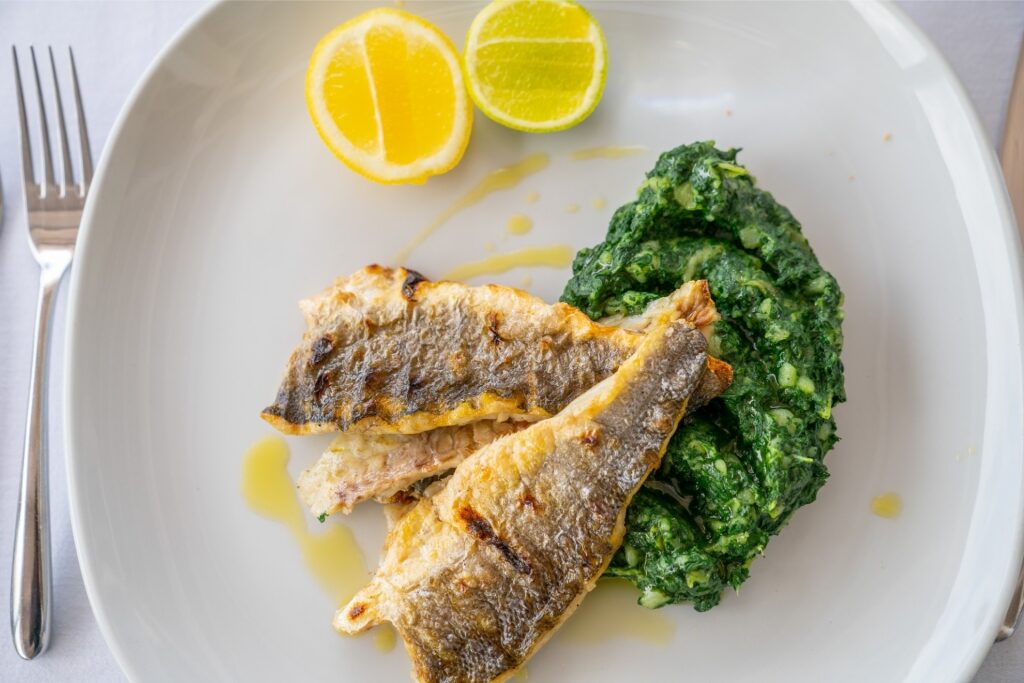
Fish
Montenegro is famous for its fish and Kotor has no shortage of good restaurants to experience that. Signature dishes to try include black risotto, colored with squid ink, and fresh calamari from Kotor Bay.
As well as oysters, mussels, and squid, there is plenty of fresh fish from the Adriatic. You’ll see everything from mackerel and bream to mullet and flounder on menus.
If you prefer to catch your own fish, there are several charter boats to take you out. As well as making a catch, you will also learn more about the deep connections between local people and the sea.
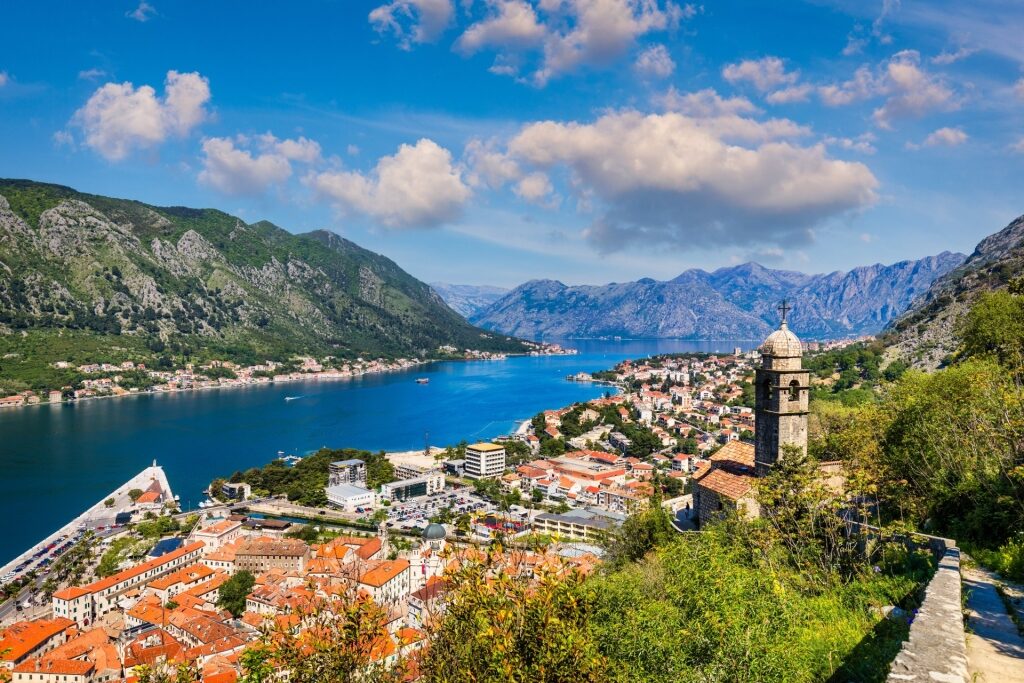
Kotor
Kotor, Montenegro, offers nature, gastronomy, culture, and spectacular scenery. Explore Celebrity’s cruises to Montenegro to discover this beguiling corner of the eastern Mediterranean.
